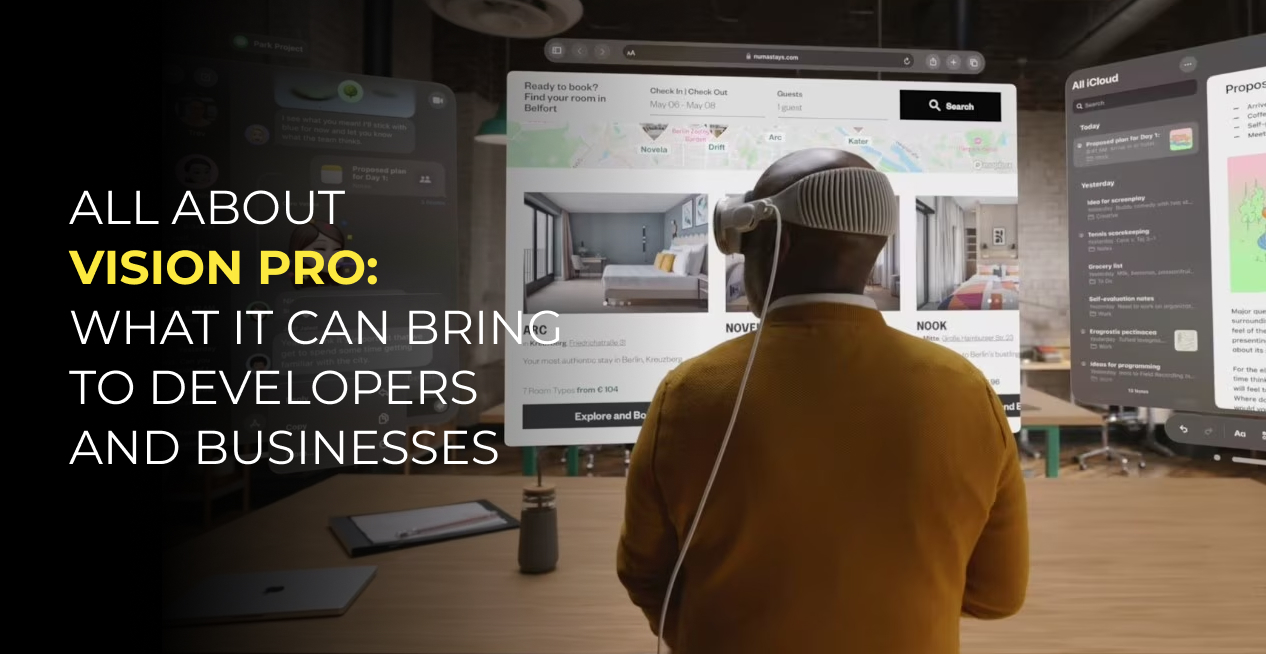Vision Pro, the long-rumored Apple augmented reality headset, was finally unveiled at the World-Wide Developer Conference earlier this week. In the past, speculation suggested Apple would release a mixed reality headset called Reality Pro, but the actual product has been named VisionPro. With a retail price of $3,499, the headset supports not only virtual reality but also augmented reality. According to Apple, it will be the world’s first spatial computer, slated to be released early next year.
The revolutionary device is not just another addition to Apple’s impressive lineup but a platform that will revolutionize how we interact with technology. An impressive suite of features makes Apple Vision Pro a testament to Apple’s innovative spirit. Read on to learn all about Vision Pro and what it can bring to developers and businesses.
What is the Apple Vision Pro and how does it work?
The Apple Vision Pro is Apple’s augmented and virtual reality headset, which has been in development for more than a decade. It is a wearable headset with a technology called “extended reality” (XR) that leverages AR-adjacent capabilities to take users beyond the confines of their screens. Using an immersive interface, users can enjoy all the iOS apps they are used to on their iPhones and iPads.
The visionOS operating system will allow users to FaceTime, make notes, organize documents, text their contacts, and design graphics. Using VisionOS, developers can create immersive panoramic experiences in augmented or extended reality with a comprehensive toolchain.
The company introduced Vision Pro at WWDC 2023 in June, marking its first entry into a new product category since the 2015 Apple Watch. It is expected to launch in early 2024. Even though the Apple Vision Pro is definitely a headset, Apple does not refer to it as such. Since it blends digital content with the physical world, Apple calls it a spatial computer.
What is VisionOS?
In a recent announcement, Apple introduced VisionOS, the operating system that will run the Vision Pro headset. Digital elements are displayed in the real world by this operating system. With visionOS, developers can create apps for the new device using familiar Apple tools such as Xcode, SwiftUI, RealityKit, and ARKit, as well as Unity and Reality Composer Pro, which prepares 3D content.
As Apple explains, developers who have apps already on the App Store or are new to developing for Apple platforms can prepare for the visionOS SDK’s release later this month. You can learn more about developing for visionOS here.
What will Apple Vision Pro bring to developers?
Developers have a world of possibilities with the Vision Pro. It allows them to reimagine existing apps or create entirely new ones for spatial computing. From immersive entertainment experiences to interactive 3D learning, the potential applications are endless.
The Vision Pro comes with tools and frameworks that developers can use to develop apps. Among these are Xcode, ARKit, SwiftUI, and RealityKit. It also streamlines the creation of 3D content for spatial applications with Reality Composer Pro.
Vision Pro Developer Kit: Getting apps ready for launch will be easier with it.
Apple will offer a Vision Pro developer kit, which is hardware that will allow you to rapidly build, iterate, and test your app or game on Apple Vision Pro. As a result, developers will be able to deliver amazing experiences. This developer kit is expected to provide the bare minimum for developers to test the look and feel of their apps rather than giving a preview of the retail version.
Developers who don’t have access to a dev kit for Vision Pro will also have the option to visit Apple’s developer labs in six cities (Cupertino, London, Munich, Shanghai, Singapore, and Tokyo), where it will offer developers “direct support” for their Vision Pro apps. Moreover, this service is only available by application.
All of these services will be available in July, although it is not clear whether the Vision Pro developer kit will be ready by then. Beginning later this month, visionOS SDK will be available in Xcode.
Can Vision Pro revolutionize the way software developers create applications and interact with them?
Using Vision Pro’s spatial capabilities could result in new and innovative apps that allow users to interact with their favorite apps, such as gaming, education, and productivity. The following are other advanced technical capabilities:
Image segmentation:
Developers have the opportunity to delve into the granular aspects of image segmentation by being able to segment images into various layers and regions and interact with them spatially by segmenting them in this manner. For diverse applications such as editing and image-based machine learning, they can analyze and manipulate specific parts of an image. This gives the developer greater control over the image and allows them to create more intricate and precise modifications. Image segmentation is an essential tool for any developer working with digital imagery.
Applications based on computer vision:
By leveraging advanced computer vision algorithms, developers will be able to build applications that detect faces and objects and possibly even detect emotions with the help of these algorithms. The capabilities can be used to develop applications for a wide variety of fields, from psychiatric therapy to security and forensic psychology. People’s behavior and emotions can be monitored in real-time through these applications, allowing for more accurate diagnosis and treatment. Additionally, they can be used to spot potential threats or suspicious behavior in public places, helping to ensure public safety.
Build and deploy seamlessly:
Through a unified API, the development process can be further simplified by integrating with other Apple frameworks, including Core ML and ARKit. It will be possible for developers to quickly build and deploy computer vision features within their applications. Developers can then focus on creating new features for their apps instead of having to worry about the complexity of integrating frameworks. Additionally, it will make the development process easier and faster for developers.
Apple Vision Pro use cases
The Apple VisionPro is presented as an entertainment device that can convert into a home theater, 3D support, and a hub for Apple Arcade applications. Additionally, it’s being touted as a powerful computer that integrates MacBook DNA with an M2 processor.
In Apple’s pitch, the device can morph into a television, into a personal workspace, into a virtual world, or into a personal sound system, depending on the use case. Additionally, it works with Apple’s Mac, keyboard, and trackpad.
Is Vision Pro useful for enterprises?
Vision Pro opens up a whole new landscape for enterprises to use computer vision for a variety of purposes. Through advances in hardware and software, new applications have been able to be developed that previously would have been impossible. This opens up exciting new possibilities across a wide range of fields. In enterprise environments, Vision Pro’s ultra-high-resolution display system can deliver a truly hands-free experience. Here are some ways enterprises can use Apple Vision Pro.
1. Provides training, information and assistance across industries
With Vision Pro, employees have access to training, assistance, and information for any task or situation. A variety of scenarios can be handled by computer vision, enabling employees to become productive at a faster pace. A camera system allows employees to receive guidance during new tasks, request information in unfamiliar environments, and call experts into situations to provide expert guidance. Onboarding of new employees can be made more efficient and error-free using computer vision.
2. Ensures the quality of manufactured goods and can assist with inspections
By using computer vision, human quality assurance and product inspection can be assisted by Artificial Intelligence. In the manufacturing process, Vision Pro can help workers identify quality issues and irregularities. Through enhanced computer vision capabilities, it is possible to cut down errors or speed up processes in order to increase productivity.
3. Field services can use it for assembly, installation, and repair
Using Vision Pro’s detailed visual instructions, any field service employee can expand their knowledge through computer vision. Enterprises can equip employees and contractors with explicit visual instructions so that they can handle a greater range of products when dispatched. Besides being able to service a greater number of products, employees will be guided during their work by visual cues and alerting.
Summing up
For enterprise businesses looking to adopt mixed reality and computer vision, VisionOS and the Apple Vision Pro offer a powerful combination of features. Users and developers alike can take advantage of the spatial computer vision technology in the Apple Vision Pro to unlock new opportunities for entertainment, collaboration, and innovation. It is expected to hit consumer markets next year, and there are tremendous possibilities for it to become a black swan event for all time. Get in touch if you are interested in leveraging OpenXcell’s AR/VR expertise to elevate the capabilities of your digital solutions.
People also ask :
Q. How much will the Apple Vision Pro headset cost?
Ans. The Apple Vision Pro headset will cost $3,499.
Q. When can I buy the Apple Vision Pro?
Ans. The Apple Vision Pro headset will be available in early 2024.
Q. What does Vision Pro do?
Ans. With Vision Pro, you can bring 3D objects to life. 3D objects can be viewed from every angle within an app as if they are right there in front of you.






